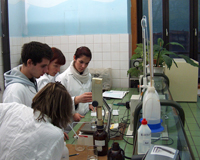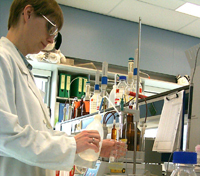StandardBase: a Leonardo da Vinci pilot project for practical education and training in chemistry Teach article
The StandardBase project has produced 72 standard analytical procedures used in industry and adapted for use by students in schools and colleges via the Internet. Ken Gadd and Luca Szalay explain the goals and the use of StandardBase products.
The aims of the StandardBase project – quality matters
How can you be sure your Coca Cola® doesn’t contain too much caffeine, your wine doesn’t have too much sulphur dioxide or the water you drink won’t harm you? It’s not likely that many people will know how to check these things. Instead, we rely on qualified analytical scientists to tell us.
Quality control in the manufacture of chemicals and products such as food, beverages and pharmaceuticals is vital. Standard analytical procedures are used to ensure quality standards are met. Analytical chemists employed in industry and the public service sector must be suitably qualified and have the skills, knowledge and experience to do their jobs well. This includes being able to use standard analytical procedures.

a StandardBase procedure
Image courtesy of the
StandardBase project team
These procedures may be local (used by specific companies), national or international. Many standards are now international, such as the International Organization for Standardization (ISO) standards. Scientists increasingly work with colleagues in other European countries and beyond. The StandardBase project was rooted in the belief that it would be beneficial to teach some common aspects of analytical procedures across vocational schools and colleges in Europe.
However, industrial standard analytical procedures often cannot be carried out in schools because of a lack of specialist equipment, chemicals, expertise and time. The StandardBase project set out to make industrial standard analytical procedures accessible to students in schools and colleges. Procedures were adapted for use in these locations, piloted, revised and added to the StandardBase website for people to use. In addition, a facility is provided for students to share and compare their results with students in other institutions and countries.
Teachers involved in the piloting of the project found that the motivation aspect was significant. Putting the science into real-life situations interests and engages students. Measuring the alcohol content of a bottle of beer, for example, is more meaningful and relevant to students than measuring its concentration in a mixture prepared by the teacher.
Methodology and outcomes of the StandardBase project
Colleagues associated with four of the partner institutions (Petrik Vocational School in Hungaryw1, Drenthe College in the Netherlandsw2, Institute ‘Jozef Stefan’ in Sloveniaw3 and 4science in the UKw4) developed and trialled 18 standard procedures each, giving a total of 72. Each institution, together with Eötvös Loránd University in Hungaryw5, tried out the procedures developed by the others. The modified procedures and results were put on the StandardBase websitew6.
Analyses fell into two categories:
- Commercially available products
Colleagues in each institution analysed the same branded commercially available product, e.g. toothpaste, aspirin and other pharmaceutical products, cola, petrol and bubble gum (specific details are available on the StandardBase website). This allowed a direct comparison. In effect, school laboratories could participate in a ‘laboratory proficiency test’. - Environmental studies
Colleagues in each institution analysed environmental samples taken from their own locality, e.g. air and water. Students would not expect to get the same results as one another. However, they could look for trends and patterns in data collected from different locations.
In addition to the procedures, tests were written so that students could check their own understanding. The final stage was for students in each country to try out the procedures. While this work was in progress, VaProw7, in the Netherlands, and Eötvös Loránd University developed the StandardBase website.
The website is now complete and students may: download procedures; download tests to check their understanding; compare their data with other students’ results; add their own results to the database; learn more about the techniques and underpinning principles; and ask questions with the help of the discussion forum and email facilities.
The StandardBase project aims to make the learning process student-centred. Information and exchange of ideas and data come primarily from the Internet rather than the teacher. This helps to develop some of the professional skills needed by practising scientists. The role of the teacher may be limited to organising and supervising the practical work.
Brief summaries of a few StandardBase procedures
Determination of citric acid in Hubba-Bubba chewing gum using acid-base titration

Image courtesy of the
StandardBase project team
The aim of this analytical procedure is to determine the citric acid content in Hubba Bubba bubble gum. This bubble gum is available in the UK and most parts of Europe. The method described is based on an analytical procedure used by the Wrigley company in their laboratories in Plymouth, UK.
A detailed description of the procedure is published in this issue of Science in Schoolw8.
Determination of fluoride ion content of toothpaste using potentiometry
Fluoride is added to drinking water and toothpaste to inhibit dental caries; it is also present in effluents from many industrial processes, e.g. the manufacture of fluoro-polymers. In this analysis, a solid state ion selective electrode (ISE) is used to measure the potential of a fluoridated toothpaste sample (or fluoridated water sample).
Determination of zinc in multivitamin tablets using stripping voltammetry
In the pharmaceutical industry, it is often necessary to determine the presence of metals in very small amounts, e.g. trace elements in multivitamin tablets. This method is applicable for the determination of zinc in the concentration range of 10-200 μg/dm3.
Coming next: Problem-based activities for vocational science education

Image courtesy of the
StandardBase project team
Students in schools and colleges of vocational education and training often follow established practical procedures. For example, they might determine the nitrate or phosphate concentration in a solution. Putting these analyses into the context of a real problem – Why is this lake water green? – illustrates their relevance and usefulness. To develop broader professional skills as well as analytical techniques, students might work within a number of constraints, e.g. limited time, budget and resources. Several analytical procedures might be provided, with students deciding which is most suitable for this situation.
So, the analytical techniques and underlying theory remain, but students are also challenged to use them in a situation that imitates authentic workplace practice. Therefore the ProBase project team (formed by the same partners who took part in the StandardBase project) wants to develop a range of activities to show not just how science works, but how scientists work. In this project, students use scientific knowledge to tackle problems. They (a) work in teams, (b) manage their time, workload and resources, and (c) communicate with one another and with non-scientists. These are the essential skills used by practising scientists.
How to access the procedures and activities
To download a StandardBase procedure, go to the StandardBase websitew6 and click on the following links in order: ‘Enter procedures database’, ‘View or conduct a StandardBase procedure’, and ‘View all experiments’. Now you can choose an experiment from the list by clicking on its title, and the description of the experiment can be downloaded in PDF format by clicking on the link ‘Show step-by-step’ on the left-hand side of the page. Alternatively, you can find a procedure suitable for certain purposes by choosing among or typing in keywords (e.g. ‘Vitamin C’) once you click on the ‘View and conduct an experiment’ link.
The ProBase websitew9 is under construction and will be ready by the end of 2008.
The Leonardo da Vinci programme
The StandardBase project was, and the ProBase project is, carried out in response to the goals of the Leonardo da Vinci programme and with the help of the Leonardo funds.
The Leonardo da Vinci programme contributes to the implementation of a vocational training policy for the European Union, which supports and supplements the actions of the member states (article 150 of the treaty establishing the European Community). The council decision states the need to raise the quality, innovation and European dimension of vocational training systems and practices, by means of transnational co-operation.
(Source: The Leonardo da Vinci Programme’s Call for proposals)
Web References
- w1 – Petrik Vocational School, Hungary: www.petrikl.sulinet.hu
- w2 – Drenthe College Unit Techniek, the Netherlands: www.drenthecollege.nl
- w3 – Institute ‘Jozef Stefan’, Slovenia: www.ijs.si/ijs.html
- w4 – 4science, United Kingdom: www.4science.org.uk
- w5 – Eötvös Loránd University, Hungary: www.elte.hu
- w6 – The StandardBase website: www.standardbase.com
- w7 – VaPro, the Netherlands: www.vapro.nl
- w8 – For a full description of the chewing gum analysis, see the following article in this issue of Science in School:
- Gadd K, Szalay L (2008) Chewing flavours. Science in School 8: 34-37.
- w9 – The ProBase website is under development but is expected to be ready by the end of 2008: www.pro-base.eu
Review
The article on the StandardBase project gives the reader a view of the dynamic world of vocational education and of the potentialities offered by European transnational programmes in this specific field.
With a plain style the authors highlight the main features of the project, leaving the rest to the project’s website, which is very rich in analytical procedures and other didactical materials. StandardBase’s winning ideas are the international standardisation of protocols, the quality assessment through laboratory proficiency tests, the real-life experiences and e-learning-based methodology.
The article could be used to raise the interest of secondary-school students by challenging their skills using the proposed activities. In addition, the StandardBase website allows students and teachers to exchange information and compare results, adding a European dimension to the learning process.
Giulia Realdon, Ita





